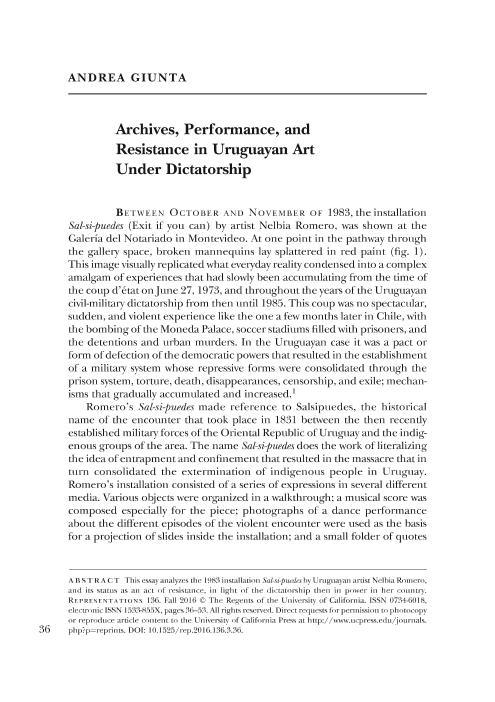Mostrar el registro sencillo del ítem
dc.contributor.author
Giunta, Andrea Graciela

dc.date.available
2020-09-25T18:00:03Z
dc.date.issued
2016-09
dc.identifier.citation
Giunta, Andrea Graciela; Archives, performance, and resistance in Uruguayan art under dictatorship; University of California; Representations; 136; 1; 9-2016; 36-53
dc.identifier.issn
0734-6018
dc.identifier.uri
http://hdl.handle.net/11336/114889
dc.description.abstract
Between october and november of 1983, the installation Sal-si-puedes (Exit if you can) by artist Nelbia Romero, was shown at the Galer ́ıa del Notariado in Montevideo.The installation combined a series of social, political, and aesthetic plots. On the one hand, it proposed a reading of a past massacre in a con- temporary repressive context. On the other hand, it aimed to stage the subjectivities conditioned by the climate of censorship through a complex, interdisciplinary web. The reception and interpretation of the piece must therefore be understood in the repressive context of the dictatorship. Tes- timonies from Romero?s contemporaries evidence a use of opaque and complicit codes, means of expression that remain inconspicuous to the castrating gaze of the dictatorship and allow us to imagine microsocieties of meaning and dialogue from which reading communities were formed. I think of these collectives as part of the intellectual and artistic networks that sought to articulate dissident messages and activities in relation to repressive. state control during the years of the dictatorship. In addition to these net- works and messages, in this essay, I?m also interested in addressing the historicist effect of Romero?s installation, into which archival documents were incorporated as a way of bringing unresolved aspects of the past into the present. In no way, of course, do I intend to resolve them, but I aim, precisely, to point out their latency and unrest. Taken together, the dispa- rate parts of Sal-si-puedes is a package of experiences that appeals at the same time to the body and to the different senses with which the documents of the past are interwoven in contemporary thought and experience.
dc.format
application/pdf
dc.language.iso
eng
dc.publisher
University of California
dc.rights
info:eu-repo/semantics/openAccess
dc.rights.uri
https://creativecommons.org/licenses/by-nc-sa/2.5/ar/
dc.subject
Archivos
dc.subject
Performance
dc.subject
Dictadura
dc.subject
Uruguay
dc.subject.classification
Arte, Historia del Arte

dc.subject.classification
Arte

dc.subject.classification
HUMANIDADES

dc.title
Archives, performance, and resistance in Uruguayan art under dictatorship
dc.type
info:eu-repo/semantics/article
dc.type
info:ar-repo/semantics/artículo
dc.type
info:eu-repo/semantics/publishedVersion
dc.date.updated
2020-09-24T17:28:50Z
dc.journal.volume
136
dc.journal.number
1
dc.journal.pagination
36-53
dc.journal.pais
Estados Unidos

dc.journal.ciudad
San Francisco
dc.description.fil
Fil: Giunta, Andrea Graciela. Universidad de Buenos Aires. Facultad de Filosofía y Letras. Instituto de Teoría e Historia del Arte "Julio E. Payró"; Argentina. Consejo Nacional de Investigaciones Científicas y Técnicas; Argentina
dc.journal.title
Representations
dc.relation.alternativeid
info:eu-repo/semantics/altIdentifier/doi/https://doi.org/10.1525/rep.2016.136.1.36
dc.relation.alternativeid
info:eu-repo/semantics/altIdentifier/url/https://online.ucpress.edu/representations/article-abstract/136/1/36/67180/Archives-Performance-and-Resistance-in-Uruguayan?redirectedFrom=fulltext
Archivos asociados
